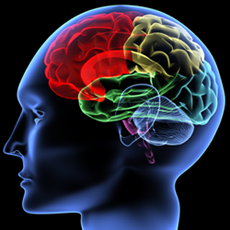Lesson 12: Co-occurring Disorders - Part 1
Attention
Mental Illness presents a major challenge and burden to our society

Learning Outcomes
Upon completion of this lesson's material, students will
- Understand and be able to describe the overall variety of mental disorders
- Understand the concept of "serious mental disorder" (SMI) and the effect of SMIs on ability to enjoy life and do well.
- Understand the prevalence of SMIs and SUDs and the proportion of people with these disorders who are getting treatment
- Be able to state what is currently understood about the neurophysiological connections between SUDs and other mental disorders
- Understand and be able to state the goals of primary, secondary and tertiary prevention and how they relate to the work of MHRT C's
Teaching
A Panoply of Mental Disorders
These are good links, but you can also refer to the DSM-V.
- Neurodevelopmental
- Schizophrenia spectrum and other psychotic disorders
- Bipolar and related disorders
- Depressive disorders
- Anxiety disorders
- Obsessive-compulsive and related disorders
- Trauma and stressor related disorders
- Dissociative disorders
- Somatic symptom and related disorders
- Feeding and eating disorders
- Elimination disorders
- Sleep-wake disorders
- Sexual dysfunctions
- Gender dysphoria
- Disruptive, Impulse-Control and Conduct disorders
- Substance-related and addictive disorders
- Neurocognitive disorders
- Personality disorders
- Paraphilic disorders
- Other mental disorders
The MHRT Role
MHRTs work with people who have Serious Mental Disorders or Severe and Persistent Mental Disorders. For the most part, these are people in the first eight categories mentioned above, excluding neurodevelopmental disorders which are treated by a different set of professionals in Maine. This is because historically in Maine, mental health, mental retardation and substance abuse have been seen as different domains although all are mental disorders.
A SMI is a mental disorder causing persisting functional impairment so that people who have these disorders may need disability income (SSI or SSDI) and assistance with activities of daily living (ADLs) over a period of years or for their entire life. One way of measuring this disability is the concept of YLDs and the burden of the disability can be calculated through the DALY. Here is a chart documenting the disability burden associated with various mental disorders DALYs. As you can see, mood disorders, anxiety and substance use account for the bulk of the losses documented in this chart.
The National Alliance for the Mentally Ill points out in the Mental Illness Fact Sheet in the Attention Section that the prevalence of mental disorders in the U.S. in a year is almost 25% while the prevalence of SMIs is almost 6%. And 5% of adults meet the criteria for a co-occurring disorder in any given year. 46% of the homeless population meet the criteria for a mental illness or SUD or both. Approximately 60% of adults and 50% of youth, however, get no treatment even though they have diagnosable mental disorders. This is especially alarming because half of mental disorders develop by age 14 (75% by age 24) and early treatment can really help in diminishing severity and persistence of symptoms.
Since the mid-1990's people cannot get SSI or SSDI for SUDs unless they have a co-occurring mental illness. This reflects the thinking that people with SUDs don't really have a disease but rather a poorly chosen lifestyle which they could change if motivated. The kernel of truth here is the word motivation which is part of the disease of addiction. But the misunderstanding is that the problem with motivation in SUDs is lack of will power. Actually people with SUDs often want to and often try to change but find that the struggle is too much for them. We saw this with tobacco addiction where the median number of quit attempts before smokers finally succeed is seven and that many smokers just lose hope of ever changing.
There is a motivational issue associated with SUDs but it is a neuropsychiatrically based problem with the fronto-limbic system. If people could just stop addiction through will power, most would because by the time they qualify for the diagnosis of SUD, use of the substance is no longer enjoyable. They have entered what Markus Heilig in our textbook calls “the dark side of addiction”. What people in this condition need is medication and counseling to help create hope, self-efficacy and a path to recovery and to begin healing their broken brain.
MHRT/Cs will see many consumers with co-occurring SUDs and you have been learning about the variety of these SUDs and how to help people who have them.
Our job is to help them deal with their disability to do the best they can to actualize their human potential and to overcome barriers (in SUDs a barrier to employment or renting an apartment might be a past criminal history) and handicaps ( a handicap in SUDs might be cravings associated with a situation that the client has to deal with at school, home or work, like for instance, a recovering alcoholic home health aide having to work in a home where there is drinking).
Probably the most difficult part of the MHRT/C job in working with co-occurring disorders will be helping people who have a SUD that is clearly hurting them but who are not yet ready to change. The rehabilitation approach here is key: to simply accept the disability and help the consumer to do their best anyway. An example would be helping a consumer who doesn't want to stop drinking to figure out how to minimize the impact of their drinking in producing outcomes they don't want. So for example, we might work with them on limiting their drinking to times when they don't have other activities or if they feel they have to drink even then to minimize the harm by getting someone else to drive, by choosing activities that don't require good coordination or good judgement. This is part of the harm reduction approach to addictions that we have discussed elsewhere.
All mental disorders involve Central Nervous System issues

Neurotransmitter issues are often central to symptoms and disability. Schizophrenia is considered to be due to an excess of dopamine in certain areas of the brain, especially the prefrontal and mesolimbic areas. This theory is supported by the effectiveness of anti-psychotic meds that are dopamine blockers. Anxiety is seen as related to GABA/Glutamate and epinephrine issues while depression is seen as related to serotonin.
Often substances offer partial relief of the neurotransmitter problem associated with the mental disorder but in the long-term may aggravate the disorder. For example alcohol may initially relieve anxiety but heavy use over a long period actually exacerbates the problem. Or with depression which again initially may be relieved but in the long term is worsened by stimulant use. This short-term/relief, long-term/exacerbation seems to be a common pattern in co-occurring consumers and part of our task is to help sensitize them to this phenomenon so that when they perceive it for themselves they may be motivated for change. We can point out how substances at first feel good but then make them feel worse and that they can modify this by reducing use and finding new ways to feel good. For example, a consumer who is medicating the negative symptoms of schizophrenia with nicotine but who has developed respiratory problems due to smoking can be helped to find cognitive and behavioral tools to reduce negative symptoms such as mindfulness, focused breathing and cognitive enhancement therapy
Neurotransmitters are not only affected by other chemicals but may also be affected by learning and other environmental factors. For example, riding a roller coaster or even thinking about it is enough to get the adrenaline flowing as effectively as cocaine. Or to use another example, one theory of PTSD is adrenaline flooding due to stress that overtaxes the individual's adaptive resources and causes a persistent change in the brain circuitry, a kind of short-circuiting, that is only overcome as the person experiences effective coping while re-experiencing the stressor. In both these examples, experiences and thoughts produce changes in neurotransmitters and in the brain as effectively as substances or medications. The relevance for MHRT/Cs is to help consumers understand that changes in life circumstances and in thoughts and feelings can also help them to feel better so that they can replace substances with more effective coping
Our job is to reduce harm and maximize functionality as determined by the client

An OUNCE of PREVENTION is worth a POUND of CURE
Primary Prevention
- Healthy practices that prevent the disease from occurring
- The two main things that discourage the development of substance disorders in youth is healthy parent modeling and clear limits set by parents
- In an SMI population we can prevent substance disorders through education (e.g. on the risks of smoking), through helping consumers to have healthier choices (e.g. recreational opportunities, socially satisfying relationships, volunteer activities, etc.), and through helping them to avoid situations and activities that put them at risk.
Secondary Prevention
- Treating the disease in early stages to cure it or prevent it from getting worse
- With substance disorders in a SMI population we often work towards harm reduction but always hope for remission and flourishing
- With chronic disorders such as diabetes, hypertension and SUDs, secondary prevention is to get the treatment that prevents the disorder from progressing and keeps the patient in remission/recovery
Tertiary Prevention
- Includes the activities that address managing the fully developed disease to minimize its impact
- Helping people who have the disease to do their best
- You may have polio but you can be President!
- You may have bipolar disorder but you can be Prime Minister!
- Tertiary prevention is the heart of psychosocial rehab
- We help people who have issues that otherwise might devastate their lives to do their best: to live long and be happy
The best source of information on the etiology, development, progression, and prognosis of mental disorders is the Diagnostic and Statistical Manual of Mental Disorder (5th Ed) or the DSM-V
Treatment of mental illness is widely diverse. Click HERE to view a webpage on the NAMI site regarding treatment. Another source of information related to the treatment of mental illness is WebMD. Simply type "Treatment of..." and insert the name of the disorder.
Assessment

Lesson 12 Quiz
- Would an MHRT/C be allowed to help a client who's only Mental Disorder was a SUD (no co-occurring mental illness)? Why or why not? (10 points). Explain why this is or is not a good thing. (10 points)
- Define SMI (10 points). List and describe four things an MHRT/C can do to help a person with a SMI (10 points). Would your work be any different with a co-occurring SUD? Why or why not (10 points)?
- What is the most prevalent SMI? Say where you found your information. (10 points).
What is the most prevalent SUD? Where did you find this information? (10 points)
What is the most prevalent co-occurring disorder? Where did you find this? (10 points) - Here's a tough one that's going to require a little research and thinking: If Schizophrenia is related to excessive dopamine in the mesolimbic area, why aren't people with schizophrenia happier? (10 points). Hint: this question can be fully answered with a single sentence.
- Define and explain primary, secondary, and tertiary prevention, especially relating in each case to the work of an MHRT/C (10 points for each category of prevention).
Lesson 12 Discussion
Write two or three paragraphs advocating for the inclusion or defending the exclusion of SUDs as SMIs qualifying a person as disabled and eligible for disability income and services.
Lesson 12 Assignment
For this assignment you are going to create a visual presentation with a voice over recording. There are some choices in terms of how you want to create a presentation For more information on creating videos on your iPad click HERE. |
Follow the steps below:
- Select a Substance Use Disorder from DSM-V (you can find a copy at Lunder or Averill Libraries) and research information about that disorder.
- Research the same Disorder using the NAMI and WebMD resources described in the Lesson.
- Construct a presentation using the options listed above.
Submit the link to your movie to the Blackboard dropbox for this assignment (simply paste it into the text box).
